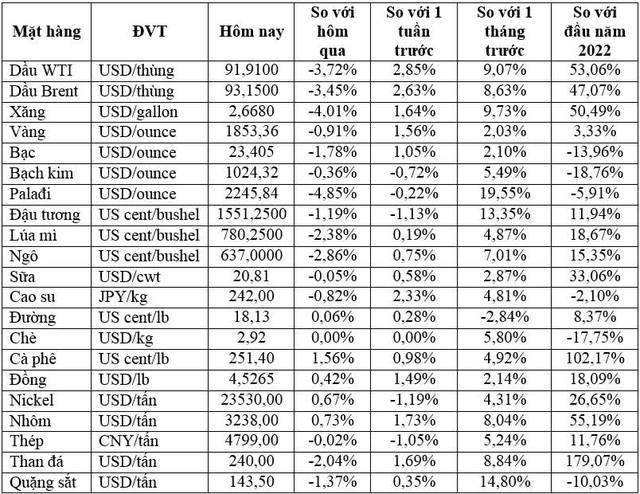Oil falls from 7-year high
Oil prices fell more than 3% from a seven-year high as Russia said some of its military units were returning to bases after exercises near Ukraine, a move that de-escalated tensions between Moscow and the West.
Closing session on February 15, Brent crude oil fell by 3.2 USD or 3.3% to 93.28 USD/barrel. WTI crude fell $3.39, or 3.6%, to $92.07 a barrel. Both grades hit their highest levels since September 2014 in the previous session. Brent is up 50% in 2021, while WTI is up around 60%, due to a recovery in global demand from the Covid-19 pandemic.
Investors are also keeping an eye on talks between the US and Iran on restoring Iran’s nuclear deal with world powers, which could allow Iran’s oil exports to increase.
Underscoring the tight balance of supply and demand, weekly US inventory reports are expected to show crude inventories falling by 1.6 million barrels, to their lowest level in more than three years.
Gold, palladium drop as tensions over Ukraine ease
Precious metal prices fell with gold falling from multi-month highs and palladium down more than 5% on news that Russian troops near Ukraine were returning to their bases.
Spot gold fell 0.8 percent to $1,855.06 an ounce after hitting its highest since June 11, 2021 at $1,879.48 an ounce. US gold for April futures closed down 0.7% at $1,856.2 an ounce.
Stocks and other risk assets have recovered slightly, stopping the sell-off of the past few days. Meanwhile, data showed U.S. producer prices rose more than expected in January. Higher-than-expected inflation data are weighing on the gold market as it could prompt the Federal Reserve to raise prices. interest rates faster.
Palladium fell 4.6% to $2,252.68 an ounce after fear of supply disruptions caused by the Russia-Ukraine conflict pushed prices to two-week highs in the previous session.
The price of copper increases
Three-month copper on the London Metal Exchange (LME) rose 0.5% to $9,965 a tonne after gaining 0.6% in the previous session. Copper on the Comex exchange rose 0.6% to $4.54/lb.
The metal market in the short term is still influenced by the situation in Ukraine. Excluding geopolitical pressures, the overall trend is bullish for most metals. Expected target for copper is 11,000 USD/ton, aluminum is 3,500 USD/ton and nickel is 30,000 USD/ton.
Buying demand in China is expected to begin to recover in the next few weeks as the economy returns to normal following the Lunar New Year holiday, with copper stocks likely to remain at multi-year lows in the short term.
Iron ore plunges
Iron ore prices fell as investors withdrew from the commodity amid fears of tightening Chinese policy, with Beijing warning it would take action against the spread of price misinformation.
Iron ore for May delivery on the Dalian Commodity Exchange fell 10%, the one-day limit at 699 yuan ($110.08) a tonne, the lowest since January 18.
This steel production component for March term in Singapore fell about 13.8% to 127.9 USD/ton.
The continued sell-off in iron ore reflects investor anxiety as China’s state planning agency, along with market regulators, will convene domestic and foreign iron ore investors at a meeting. on February 17, in an effort to ensure market stability.
Spot iron ore with 62% Fe content fell to $149 a tonne on January 14, after near a six-month high of $152.5 a tonne last week, according to data from SteelHome.
Steel bars used in construction in Shanghai fell 2.8%, hot rolled coil decreased 2.7%. Stainless steel increased 1.4%.
Japanese rubber reduced by Shanghai price
Rubber prices in Japan fell after six days of gains, as prices fell in Shanghai and Asian stocks weakened amid tensions between Russia and Ukraine.
Rubber for July delivery on the Osaka exchange fell 3.4 JPY or 1.3% to 254.2 JPY (2.2 USD)/kg after 6 sessions of gains. Rubber touched an 8.5-month high in the previous session.
Rubber contract for May delivery in Shanghai fell 275 CNY to 14,355 CNY ($2,260.17)/ton.
Falling line
Raw sugar for March delivery closed down 0.05 US cents or 0.3% at 18.07 US cents/lb .
Dealers say the market remains in a range of 17.77 to 18.68 US cents/lb this month, with the outlook likely to depend on how well cane and sugar production in south-central Brazil recovers in crop year 2022/23.
A poll by broker Marex put an average sugarcane output forecast in Brazil’s south-central region at 554 million tonnes, slightly down from the average forecast of 560 million tonnes in a Reuters poll from last month. Marex polling also forecast sugar production in the region at 33.81 million tonnes, slightly lower than the 34.35 million tonnes forecast in the Reuters poll.
Brazil’s Unica said that the country’s ethanol producers sold the fuel 32 percent less than in the same month of January a year ago.
White sugar for May futures fell $2.2, or 0.5%, to $480 a tonne.
Coffee rose
Arabica coffee for May delivery closed up 3.85 US cents or 1.6% at $2.5175/lb, towards a 10-year high at $2.6045 reached last week.
Dealers say a sharp drop in arabica stocks remains an important supportive factor.
Robusta coffee for May futures rose $22 or 1% to $2,265/ton.
Wheat, corn and soybeans fell
Wheat and corn prices on the Chicago Mercantile Exchange fell on the announcement that some Russian military units had withdrawn to base. Soybeans fell due to the possibility of rain in arid growing areas in Argentina and southern Brazil.
CBOT wheat contract closed down 19-1/2 US cents to 7.79-3/4 USD/bushel.
CBOT soybeans fell 18-3/4 US cents to 15.51-1/4 USD/bushel. Corn fell 17-3/4 US cents to 6.38 USD/bushel, down 2.71%, the biggest daily drop since July 23, 2021.
Prices of some key items in the morning of February 16:

